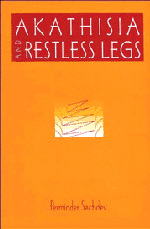Book contents
- Frontmatter
- Contents
- Foreword
- Acknowledgements
- Abbreviations
- Part I Introduction
- 1 Akathisia: development of the concept
- 2 The anatomy of restlessness
- 3 Neuroleptic-induced dysphoria
- Part II Drug-induced akathisia
- Part III Restless legs syndrome
- Part IV Conclusions
- Appendix A Haskovec's Akathisie
- Appendix B Prince Henry Hospital Akathisia Scale
- Appendix C Barnes (1989) Akathisia Rating Scale
- Appendix D Hillside Akathisia Scale (version 4)
- References
- Index
2 - The anatomy of restlessness
from Part I - Introduction
Published online by Cambridge University Press: 12 September 2009
- Frontmatter
- Contents
- Foreword
- Acknowledgements
- Abbreviations
- Part I Introduction
- 1 Akathisia: development of the concept
- 2 The anatomy of restlessness
- 3 Neuroleptic-induced dysphoria
- Part II Drug-induced akathisia
- Part III Restless legs syndrome
- Part IV Conclusions
- Appendix A Haskovec's Akathisie
- Appendix B Prince Henry Hospital Akathisia Scale
- Appendix C Barnes (1989) Akathisia Rating Scale
- Appendix D Hillside Akathisia Scale (version 4)
- References
- Index
Summary
Restlessness: aimless activity, pottering, desultoriness, inattention, unquiet, fidgets, fidgetiness, agitation, fever, fret, frenzy, eagerness, enthusiasm, ardour, abandon, warm feeling, vigour, energy, dynamism, aggressiveness, militancy, enterprise, initiative, push, drive, ego, pep, vigorousness, watchfulness, vigilance, carefulness, wakefulness, sleeplessness, insomnia.
Roget's Thesaurus (1983)To place akathisia and RLS in perspective, it would be helpful to review the usage of the term restlessness in neuropsychiatry in general. The term has been applied in a variety of clinical states, often without a precise definition. It has also been used to describe some aspects of normal behaviour. A number of related terms have additionally been used – akathisia, agitation, fidgetiness, hyperactivity, jitteriness – to describe phenomena that resemble, or overlap with, restlessness. They share the common theme of aimless motor activity that is poorly organized and represents a state of physical or mental unease. The clinical application of various terms related to restlessness has been imprecise and often idiosyncratic. Some terms have dominated descriptions in certain contexts; yet without accompanying definitions, their use is limited. For example, in the context of melancholic depression, agitation has been the preferred term (Lewis, 1934; Nelson and Charney, 1981), even though a distinction from restlessness or hyperactivity is not always clarified. The term jitteriness has been used to describe restlessness induced by tricyclic drugs (Pohl et al, 1988), but its phenomenological distinction from restlessness due to other drugs has not been examined.
- Type
- Chapter
- Information
- Akathisia and Restless Legs , pp. 18 - 46Publisher: Cambridge University PressPrint publication year: 1995



